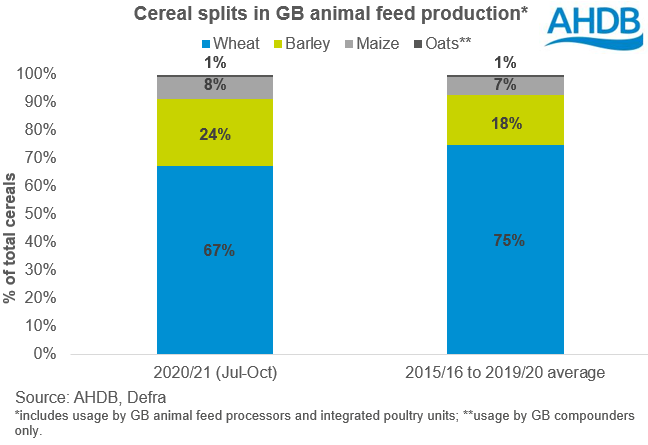Wheat continues to drop out of feed rations: Grain Market Daily
Tuesday, 8 December 2020
Market Commentary
- Both old (May-21) and new crop (Nov-21) London wheat futures found marginal support yesterday, closing up £0.65/t and £0.25/t respectively. This was off the back of a weakening pound due to uncertainty over a future trade deal with the EU.
- Rains in parts of Brazil’s key growing regions caused Chicago soyabeans to fall again, with the May-21 contract losing $1.84/t from Thursday to Monday’s close.
- Both Brent and US crude oil fell by 1% yesterday due to surging coronavirus cases and increased tension between the US and China. This has undermined the positive impact on prices from an OPEC+ production deal.

Wheat continues to drop out of feed rations
It’s no surprise, with barley at such a discount to wheat, that the proportion of wheat included in GB animal feed production* has shrunk since the start of the season.
Over the past five seasons (2015/16 to 2019/20) around 75% of all cereals used in GB animal feed production* was wheat. So far this season (July to October), just 67% of the total was wheat, with barley inclusions up on the average, currently at 24%.
At the end of last season we saw barley inclusions in animal feed creep up, but reports suggested that barley was being ‘maxed out’ in some rations.
At the end of June 2020 the UK average ex-farm feed barley price was at a discount of around £30/t to feed wheat. This would have been described as significant at the time.
Fast forward a few months and the discount became even larger, touching near £50/t at the end-October. Barley is now at around a £46/t discount to feed wheat (as at 3 December).
With the gap between the two feed grains widening further since the start of 2020/21, we have seen more barley included in rations. As the price of barley is ‘that’ favourable, the proportions of barley used in poultry feed have even increased.
The latest cereal usage data was published last Thursday and gave us information up to end-October. The price relationship between feed barley and wheat has not changed much since then. As such, strong barley usage could have continued in November and is likely to continue in December, if not beyond.
High domestic wheat prices and a very tight supply mean the use of maize in feed rations can’t be over looked. Since the start of the season, the proportion of maize used has crept up slightly too.
Imported maize looked very competitive into certain regions earlier in the season. Despite prices rising quite considerably in recent months, it has been reported that many processors bought maize forward. This means we could see strong inclusions until at least the end of the year.
Beyond 2020
Looking further ahead and with such a tight domestic wheat market and a greater barley surplus, it is very likely that barley inclusions in feed rations will remain strong throughout the season.
Whether maize inclusions continue to be strong very much depends on price. At the moment maize isn’t looking the most competitive into GB, however this could change.
In the latest balance sheets for 2020/21, wheat usage in animal feed is pegged at a multiyear low, while barley inclusions are set to rise considerably. Maize demand in animal feed is currently expected to remain stable on the year.
*Includes information from compound feed processors and integrated poultry units.
Sign up for regular updates
You can subscribe to receive Grain Market Daily straight to your inbox. Simply fill in your contact details on our online form and select the information you wish to receive.
While AHDB seeks to ensure that the information contained on this webpage is accurate at the time of publication, no warranty is given in respect of the information and data provided. You are responsible for how you use the information. To the maximum extent permitted by law, AHDB accepts no liability for loss, damage or injury howsoever caused or suffered (including that caused by negligence) directly or indirectly in relation to the information or data provided in this publication.
All intellectual property rights in the information and data on this webpage belong to or are licensed by AHDB. You are authorised to use such information for your internal business purposes only and you must not provide this information to any other third parties, including further publication of the information, or for commercial gain in any way whatsoever without the prior written permission of AHDB for each third party disclosure, publication or commercial arrangement. For more information, please see our Terms of Use and Privacy Notice or contact the Director of Corporate Affairs at info@ahdb.org.uk © Agriculture and Horticulture Development Board. All rights reserved.


